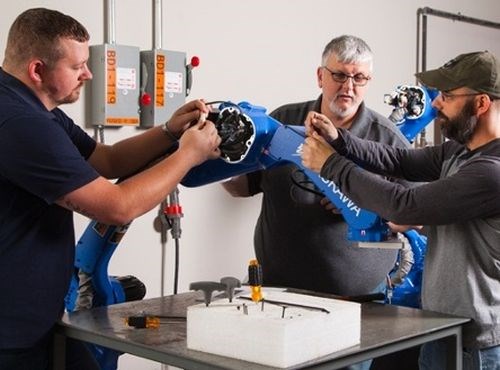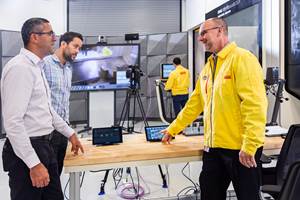Retrain or Recruit?
How do you tackle the skills gap in your company? That is the question posed in an email I received from Yaskawa Motoman not too long ago, and I thought the insight provided was worth sharing.

Here at MMT we cover education, training and workforce development a lot, but when I got this email from Buddy Smith, Yaskawa Academy Manager, Curriculum Development, MERIT at Yaskawa America, Motoman Robotics Division, I had to share his insights.
Imagine a small manufacturer that makes relatively short job runs of customized electronics boards. Once machines manufacture the boards, the facility’s staff gathers and packages the boards for shipping. The human operators understand best what can and cannot be done with the boards, but the physical labor can be done more efficiently with robots. Training a human operator to program the robot is much less costly than hiring a robot programmer. In fact, it may be three to four times less expensive to retain and train a human operator in this scenario. Similarly, in welding applications, it can be a tremendous cost savings to retain a skilled welder and teach him or her to program a robotic welder to tackle highly repetitive tasks.
Consider another example: a larger manufacturer has automated many of its processes. Due to this automation, the firm is a natural fit to eventually move to robotics. On the other end of the spectrum is a small job shop with human-intensive processes; the company is losing skilled workers to retirement. The job shop is also a candidate for robotics because it can’t easily find or train replacement workers.
While both companies are moving toward a robotics future, their workforce needs vary. The manufacturer may already have some technically inclined workers on staff who could transition easily into robotics training. Whereas, the small job shop may need to look outside its walls to hire a robotics-qualified employee.
Each company has to think about how to get a return on its robotics investment. Improving production is not just about purchasing a robot. It’s also about weighing the decision to bring in someone skilled at programming a robot or retraining an employee to program and work with a newly purchased robot.
Hiring people with robotics skills should soon be easier, at least in some places. For instance, states like Ohio and Indiana are really ramping up students’ technical skills to better prepare graduates to be employable the day they get their diploma from high school or a career training center. If a manufacturer or job shop is lucky enough to operate in or near these states, recruiting for a robotics-skilled worker might be the easiest course of action.
If a manufacturer of any size decides to add robots to its workforce, then the company’s owners and executives can and should prepare the workforce in advance. There are a lot of communication opportunities to start a dialogue with workers. Initially a company can talk about its vision for adding robots: Explain why robotics will help workers, boost production and increase profit sharing.
When a company capitalizes on these opportunities, it creates excitement by outlining how robotics can open doors to new training, provide a chance to tackle new responsibilities and reduce injuries.
The training that Yaskawa Motoman offers customers who’ve purchased a robot ranges from programming classes to maintenance courses. For our maintenance training, a student can spend one week with us and learn about 85 percent of what they’ll face on the job. That’s a terrific example of how retraining an already-employed worker can give them new skills and reap rewards for his or her employers.
Ultimately, though, the answer is not really a choice between retaining, retraining or recruiting. The solution is a mix of these things depending on the company’s position. As part of the purchase of a robot, a company wants to ensure it isn’t spending more on recruiting than retaining or vice versa. The bottom line is to not spend more on retraining than recruiting."
Related Content
Hands-on Workshop Teaches Mold Maintenance Process
Intensive workshop teaches the process of mold maintenance to help put an end to the firefighting culture of many toolrooms.
Read MoreHow to Use Continuing Education to Remain Competitive in Moldmaking
Continued training helps moldmakers make tooling decisions and properly use the latest cutting tool to efficiently machine high-quality molds.
Read MoreMaking Quick and Easy Kaizen Work for Your Shop
Within each person is unlimited creative potential to improve shop operations.
Read MoreMaking Mentoring Work | MMT Chat Part 2
Three of the TK Mold and Engineering team in Romeo, Michigan join me for Part 2 of this MMT Chat on mentorship by sharing how the AMBA’s Meet a Mentor Program works, lessons learned (and applied) and the way your shop can join this effort.
Read MoreRead Next
Are You a Moldmaker Considering 3D Printing? Consider the 3D Printing Workshop at NPE2024
Presentations will cover 3D printing for mold tooling, material innovation, product development, bridge production and full-scale, high-volume additive manufacturing.
Read MoreReasons to Use Fiber Lasers for Mold Cleaning
Fiber lasers offer a simplicity, speed, control and portability, minimizing mold cleaning risks.
Read MoreHow to Use Strategic Planning Tools, Data to Manage the Human Side of Business
Q&A with Marion Wells, MMT EAB member and founder of Human Asset Management.
Read More


























